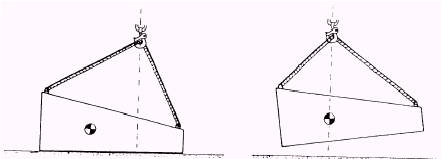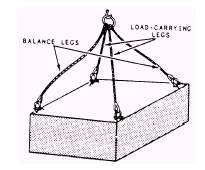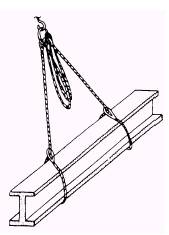|
RIGGING SAFE OPERATING PROCEDURES All personnel involved with the use of rigging gear should be thoroughly instructed and trained to comply with the following practices: 1. Wire rope slings must not be used with loads that exceed the rated capacities outlined in enclosure (2) of the COMSECOND/COMTHIRDNCBINST 11200.11. Slings not included in the enclosure must be used only according to the manufacturer's recommendation. 2. Determine the weight of a load before attempting any lift. 3. Select a sling with sufficient capacity rating. 4. Examine all hardware, equipment, tackle, and slings before using them and destroy all defective components. 5. Use the proper hitch. 6. Guide loads with a tag line when practical. 7. When using multiple-leg slings, select the longest sling practical to reduce the stress on the individual sling legs. 8. Attach the sling securely to the load. 9. Pad or protect any sharp corners or edges the sling may come in contact with to prevent chaffing. 10. Keep the slings free of kinks, loops, or twists. 11. Keep hands and fingers from between the sling and the load. 12. To avoid placing shock on the loading slings, you should start the lift slowly. 13. Keep the slings well lubricated to prevent corrosion. 14. Do not pull the slings from under a load when the load is resting on the slings; block the load up to remove the slings.

Figure 13-49.-Load shifting when Lifted. 15. Do not shorten a sling by knotting or using wire rope clips. 16. Do not inspect wire rope slings by passing bare hands over the rope. Broken wires, if present, may cause serious injuries. When practical, leather palm gloves should be worn when working with wire rope slings. 17. Center of balance. Stability of the load is important in the rigging process. A stable load is a load in which the center of balance of the load is directly below the hook, as shown in figure 13-49. When a load is suspended, it will always shift to that position below
the hook. To rig a stable load, establish the center of balance (C/B). Once you have done this, simply swing the hook over the C/B and select the length of sling
needed from the hook to the lifting point of the load.

Figure 13-50.-Multi-legged bridle sling lifting a load. 18. When using a multi-legged bridle sling, do not forget it is wrong to assume that a three- or four-leg hitch will safely lift a load equal to the safe load on one leg multiplied by the number of legs. With a four-legged bridle sling lifting a rigid load, it is possible for two of the legs to support practically the full load while the other two only balance it (fig. 13-50). NOTE: If all the legs of a multi-legged sling are not required, secure the remaining legs out of the way, as shown in figure 13-51.

Figure 13-51.-Secure sling legs that are not used.
|

